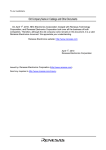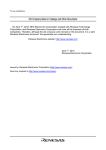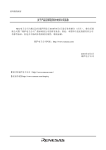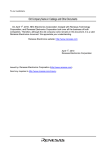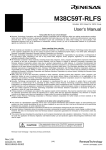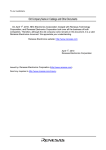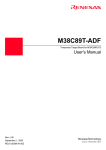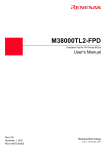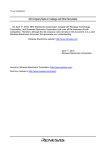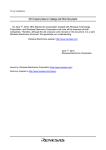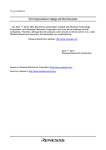Download Renesas M38C29T-ADF User's Manual
Transcript
M38C29T-ADF Temporary Target Board for M38C29RLFS User’s Manual Keep safety first in your circuit designs! Renesas Technology Corporation and Renesas Solutions Corporation put the maximum effort into making semiconductor products better and more reliable, but there is always the possibility that trouble may occur with them. Trouble with semiconductors may lead to personal injury, fire or property damage. Remember to give due consideration to safety when making your circuit designs, with appropriate measures such as (i) placement of substitutive, auxiliary circuits, (ii) use of nonflammable material or (iii) prevention against any malfunction or mishap. Notes regarding these materials These materials are intended as a reference to assist our customers in the selection of the Renesas Technology product best suited to the customer's application; they do not convey any license under any intellectual property rights, or any other rights, belonging to Renesas Technology Corporation, Renesas Solutions Corporation or a third party. Renesas Technology Corporation and Renesas Solutions Corporation assume no responsibility for any damage, or infringement of any third-party's rights, originating in the use of any product data, diagrams, charts, programs, algorithms, or circuit application examples contained in these materials. All information contained in these materials, including product data, diagrams, charts, programs and algorithms represents information on products at the time of publication of these materials, and are subject to change by Renesas Technology Corporation and Renesas Solutions Corporation without notice due to product improvements or other reasons. It is therefore recommended that customers contact Renesas Technology Corporation, Renesas Solutions Corporation or an authorized Renesas Technology product distributor for the latest product information before purchasing a product listed herein. The information described here may contain technical inaccuracies or typographical errors. Renesas Technology Corporation and Renesas Solutions Corporation assume no responsibility for any damage, liability, or other loss rising from these inaccuracies or errors. Please also pay attention to information published by Renesas Technology Corporation and Renesas Solutions Corporation by various means, including the Renesas home page (http://www.renesas.com). When using any or all of the information contained in these materials, including product data, diagrams, charts, programs, and algorithms, please be sure to evaluate all information as a total system before making a final decision on the applicability of the information and products. Renesas Technology Corporation and Renesas Solutions Corporation assume no responsibility for any damage, liability or other loss resulting from the information contained herein. Renesas Technology semiconductors are not designed or manufactured for use in a device or system that is used under circumstances in which human life is potentially at stake. Please contact Renesas Technology Corporation, Renesas Solutions Corporation or an authorized Renesas Technology product distributor when considering the use of a product contained herein for any specific purposes, such as apparatus or systems for transportation, vehicular, medical, aerospace, nuclear, or undersea repeater use. The prior written approval of Renesas Technology Corporation and Renesas Solutions Corporation is necessary to reprint or reproduce in whole or in part these materials. If these products or technologies are subject to the Japanese export control restrictions, they must be exported under a license from the Japanese government and cannot be imported into a country other than the approved destination. Any diversion or reexport contrary to the export control laws and regulations of Japan and/or the country of destination is prohibited. Please contact Renesas Technology Corporation or Renesas Solutions Corporation for further details on these materials or the products contained therein. Precautions to be taken when using this product This product is a development supporting unit for use in your program development and evaluation stages. In mass-producing your program you have finished developing, be sure to make a judgment on your own risk that it can be put to practical use by performing integration test, evaluation, or some experiment else. In no event shall Renesas Solutions Corporation be liable for any consequence arising from the use of this product. Renesas Solutions Corporation strives to renovate or provide a workaround for product malfunction at some charge or without charge. However, this does not necessarily mean that Renesas Solutions Corporation guarantees the renovation or the provision under any circumstances. This product has been developed by assuming its use for program development and evaluation in laboratories. Therefore, it does not fall under the application of Electrical Appliance and Material Safety Law and protection against electromagnetic interference when used in Japan. CAUTION Renesas Tools Homepage Rev.1.00 Apr. 19, 2006 REJ10J1356-0100 If the requirements shown in the "CAUTION" sentences are ignored, the equipment may cause personal injury or damage to the products. http://www.renesas.com/en/tools (1/8) 1. Things to Check When Unpacking The M38C29T-ADF package consists of the following products. When unpacking your package, check to see that all of these components are included. If you find any item missing or faulty, or any suggestion, contact your local distributor. Table 1.1 Package components Item M38C29T-ADF temporary target board M38C29T-ADF User’s Manual (this manual) 2. Outline The M38C29T-ADF is a temporary target board used to develop software with a compact emulator M38000T2-CPE or PC4701 emulator system. It supplies to the M38C29RLFS MCU the minimum required signals needed to operate the emulator MCU, including power supply voltage, clock signals and reset signals. Use it when the user system is not ready. 3. Specifications Table 3.1 lists the specifications of the M38C29T-ADF. Table 3.1 Specifications Applicable MCU M38C29RLFS Clock 4.0MHz oscillator mounted (oscillator circuit board OSC-2 used) 32.768kHz (can be disconnected by SW1) Vcc Supplied separately* Vss Supplied separately RESET - Reset circuit mounted (power-on reset and reset switch) - Connects the reset output of an emulation pod External dimensions Width 90mm Depth 115mm Others Universal part prepared * Power cannot be supplied from the emulator (e.g. M38000T2-CPE). A separate power supply is needed. (2/8) 4. Setting Up This chapter describes how to set up the M38C29T-ADF. (1) Mount the emulator MCU on the M38C29T-ADF. After checking the position of the No. 1 pin of the emulator MCU, mount the emulator MCU referencing Figure 4.1. (2) Insert the connector on the tip of the emulator probe to the socket on the emulator MCU. For the M38000T2-CPE, the converter board PCA4933 is required between the emulator probe and emulator MCU. No. 1 pin M38C2 9 T - ADF 1 I C1 100 100 26 J2 75 81 1 Universal part J1 80 30 5 95 35 10 65 90 30 70 51 31 40 15 50 85 3 2K OSC 20 45 J3 25 80 55 7650 51 TP1 Vcc TP2 Vs s TP3 RESET NC Vcc SW4 Vss Vc c XOUT SW3 CNVs s SW2 J1 -21 Vc c SW1 XCI N PORT VREF C6 PORT/ XCI N 1 I C3 OSC - 2 60 SW5 Universal part RESET TP4 VREF MADE I N JAPAN Figure 4.1 Position of No. 1 pin of the M38C29T-ADF's emulator MCU CAUTION Cautions to Be Taken for This Product: Always shut OFF power before connecting this product. The power ON state could destroy internal circuit. (3/8) (3) Connect the RESET cable (white) and the GND cable (black) of the emulation pod to the RESET (TP3) pin and Vss (TP2) pin of the M38C29T-ADF respectively. And connect the Vcc cable (red) to the Vcc (TP1) pin. (4) Set the MCU type select switch of the M38000T2-CPE to the RLSS side. (5) Connect a power supply (not included) to the Vcc (TP1) pin of the M38C29T-ADF. And connect the GND output of the power supply to the Vss (TP2) pin. Use the power supply whose rising time is 10ms or less. Table 4.1 lists the correspondence of the connector cables and signals, and Figure 4.2 shows the connection pattern. Table 4.1 Connector cables of the M38000T2-CPE and applicable signals Cable color WHITE BLACK RED Signal RESET Vss Vcc (SENSE) REV . B M38C29 T- ADF J1 I C1 100 81 80 1 Emulator 30 51 31 RLSS/RLFS C1 50 OSC- 2 J3 TP1 TP2 TP3 TP4 RED WH IT E BLACK +5V 0V Figure 4.2 Connection pattern of the M38C29T-ADF (4/8) S W4 SW 5 Vc c NC CNVs s S W3 Vs s Vc c CNVs s S W2 VREF S W1 J1-21 Vc c C6 XCIN PORT PORT/ XCI N 1 I C3 C5 RESET J2 (6) Setting SW Set the SW1 to SW4 according to your application. Table 4.2 describes the functions of the SW1 to SW4. Table 4.2 Functions of the SW1, SW2, SW3 and SW4 of the M38C29T-ADF No. SW1 Name PORT/XCIN SW2 VREF SW3 CNVss SW4 XOUT Function Allows you to choose whether to supply the sub-clock signals (32.768kHz) to the MCU's XCIN pin (pin 43). To use P61/XCIN as an output port, choose the PORT side. To use the sub-clock signals, choose the XCIN side. Allows you to choose whether to apply Vcc or some other source to the MCU's VREF pin (pin 21). In the case of the latter, choose the J1-21 side, and apply a voltage within a prescribed range to the J1-21. Allows you to choose which to connect, Vcc or Vss, to the MCU's CNVss pin (pin 39). Allows you to choose whether to pull up the MCU's XOUT pin (pin 46). To use the oscillator circuit of OSC-2 on the temporary target board, or to input the external clock, set SW4 to Vcc to pull up XOUT pin. To use the oscillator circuit with a resonator between XIN and XOUT, set SW4 to NC. (5/8) Factory-setting PORT Vcc Vss Vcc 5. Oscillator Circuit 5.1 Oscillator Circuit Board The M38C29T-ADF has a built-in oscillator circuit board on which a 4.0MHz oscillator is mounted. Figure 5.1 shows an external view of the OSC-2 oscillator circuit board (bare board) and where connector pins are located. Figure 5.2 shows the circuitry of the OSC-2 oscillator circuit board (bare board). Use the number of oscillator circuits recommended by the oscillator manufacturer. J1-4: GND J1-3: Oscillation output J1-2: GND J1-1: VCC Figure 5.1 External view of the oscillator board (OSC-2) and connector pin assignment IC1 IC1 11 10 9 C LK 8 J1-3 R1 * * X1 ,X2 C2 X3* 1 Vcc 2 J1-1 R2 C1 3 4 5 6 13 12 C3 14 IC1 7 J1-2 GND J1-4 IC1 GND 2-pin oscillator *X1:5.08-mm-pitch . X2:2.54-mm-pitch 2-pin oscillator X3:2.54-mm-pitch 3-pin oscillator IC1:Inverter (Unbuffer) Figure 5.2 Circuit of the oscillator board (OSC-2) 5.2 32.768kHz Oscillator Circuit The 32.768kHz oscillator circuit is prepared on the M38C29T-ADF. When using the 32.768kHz oscillator circuit as a sub-clock, set SW1 to the XCIN side. (6/8) 6. Reset Circuit Figure 6.1 shows the reset circuit and its waveform. In this product, reset is cleared in about 100ms from the instant Vcc passes about 2.1V after having started from 0 V. When Vcc drops down to about 2.1V, reset turns effective. Detected power voltage (V ) Approx. 1. 25 x (R3 + R4 ) / R4 TP3 Vcc 1 R3 6. 8 K R4 10 K RESET I C3 R5 Vcc 2 M5195 7BL OUT IN 1 0K 5 SW4 CD Vss 3 MCU RESET 4 C5 0. 33u F CD 1 .25V Input volage ( IC3- 2-pin) t H td td Output state ( IC3 - 5-pin ) L t d = 0 . 34 x CD (pF ) usec Figure 6.1 Reset circuit and its waveform By using SW5, the MCU can be reset manually. Table 6.1 Function of SW5 (reset switch) No. SW5 Name RESET Function This is the reset switch. Press down this switch to reset the MCU. (7/8) t 7. Pin Layout Figure 7.1 shows the pin layout of the M38C29T-ADF. I C1 1 J1 -1 2 J1 -2 3 J1 -3 4 J1 -4 5 J1 -5 J1 -6 6 7 J1 -7 8 J1 -8 9 J1 -9 10 J1-10 11 J1-11 12 J1-12 13 J1-13 14 J1-14 15 J1-15 16 J1-16 17 J1-17 18 J1-18 19 J1-19 J1-20 J1-21 20 SW2 VREF TP4 J1-21 VREF Vc c 21 22 J1 -22 23 J1 -23 24 J1 -24 25 J1 -25 26 J2 -26 27 J2 -27 28 J2 -28 29 J2 -29 30 J2 -30 31 J2 -31 32 33 J2 -32 J2 -33 34 J2 -34 35 36 J2 -35 J2 -36 37 J2 -37 38 J2 -38 SW3 CNV ss J2 -39 39 Vcc Vs s J2-40 TP3 RESET J2 -41 40 41 NC NC NC NC NC P04 NC P05 NC P06 NC P07 NC P10 P03 P11 P02 P12 P01 P13 P00 P14 P57 P15 P56 P16 P55 P17 P54 P53 P52 P51 P50 AV s s VREF P47 P46 NC J2-42 SW1 PORT / XCIN J2 -43 43 NC NC NC NC NC P24 NC P25 NC P26 NC P27 NC VL 3 P45 COM1 P44 COM2 P43 COM2 P42 COM3 P41 P30 P40 P31 CNVs s XCI N TP2 NC RESET 44 45 OSC - 2 4 MH z P36 P62 /XCOUT NC NC NC P61 /XC I N NC NC J2-44 J2-45 P34 P35 PORT Vs s P32 P33 NC 32.768kHz J1 -99 98 97 J1 -98 J1 -97 96 J1 -96 95 J1 -95 94 J1 -94 93 J1 -93 92 J1 -92 91 J1 -91 90 J1 -90 89 J1 -89 88 J1 -88 87 J1 -87 86 P20 85 P21 84 P22 83 P23 82 NC 81 NC 80 NC 79 NC 78 NC 77 NC 76 NC NC 42 J1 -100 99 J1 -86 J1 -85 J1 -84 J1 -83 J1 -82 J1 -81 J1 -80 J1 -79 J1 -78 J1 -77 J1 -76 NC RESET IC 10K 100 Vs s XIN J2 -75 74 J2 -74 73 J2 -73 72 J2 -72 71 J2 -71 70 J2 -70 69 J2 -69 68 J2 -68 67 J2 -67 66 J2 -66 65 J2 -65 64 J2 -64 63 J2 -63 62 J2 -62 61 J2 -61 60 J2 -60 59 J2 -59 58 J2 -58 57 J2 -57 56 J2 -56 55 J2 -55 54 J2 -54 53 J2 -53 52 J2 -52 51 NC N C 50 P37 49 J2 -51 J2-50 J2-49 P60 48 Vc c 4 3 2 1 75 J2-48 Vcc 47 NC TP1 J2-47 SW4 XOUT XOUT 46 NC Figure 7.1 Pin layout of the M38C29T-ADF (8/8) 1K Vcc J2 -46








